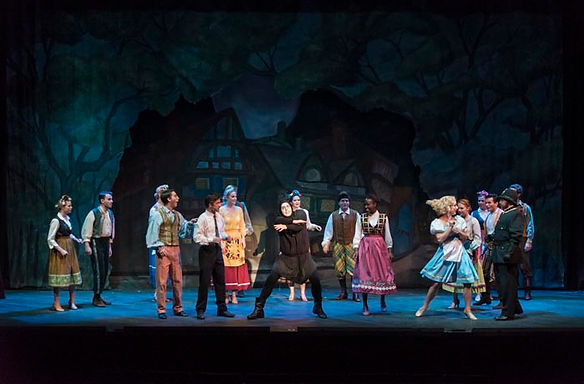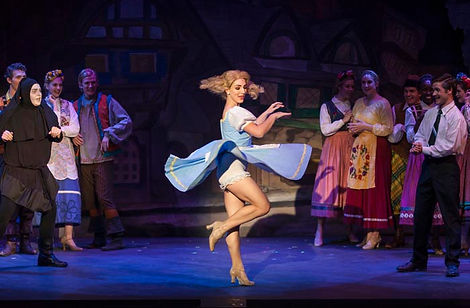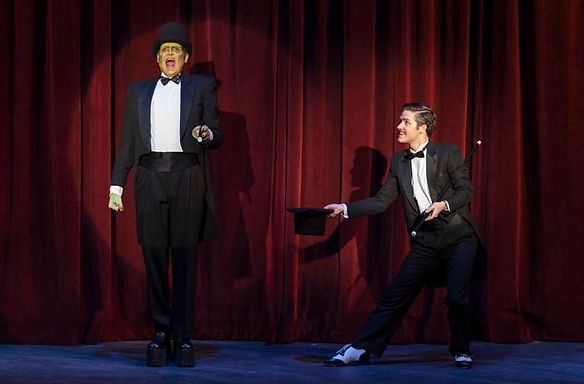

Young Frankenstein
Young Frankenstein was produced by The University of Alabama in the Fall of 2015. It was the second large cast musical that I had the opportunity to mix at the university and the first chance I had to mix on the main stage. Fortunately, I had the opportunity to assist a very accomplished professional in that space the previous year. This prepared me for some of the acoustic issues I was going to face, as well as give me an on-the-job crash course in DCA programming with the Yamaha M7 console.


One of the challenges provided by this show is the size of the case and the number of instruments in the orchestra. Our console is a 32 channel digital board, and with 23 vocalists and a 13 piece orchestra, that meant that I had to pre-mix all of the woodwinds and the various drum channels on a smaller auxiliary console before patching that feed through the M7.
Another interesting challenge was the upstage center area on that platform. It was impossible for the performers to hear the monitors from up there because the edges of the downstage platform were directly between the performer and the speaker. The solution was the move the onstage monitors into the lighting box-boom position. This was a weird issue to have, but the space designed to be an instrumental recital hall, not a theatre capable of producing large-cast musicals.




This show, like so many others, is written to flow from one scene to another with rapid and sometimes over-lapping transitions. This provides an interesting issue for the Mix Artist, but fortunately, digital consoles generally have programable scene memory-- something the M7 does really well.
The M7 scene memory function uses a feature called DCA or "Digital Control Assignments" to move from scene to scene- this means that the Mix Artist can mix the whole show and effectively only have to worry about 8 Faders. Convenient when you only have 10 fingers.
One of the really cool moments of this show is the Act I finale. the song "Transylvania Mania" is a full fledged swing-infused broadway tune, complete with dance break. All of the principle characters are present as well as the full ensemble. Its a great opportunity to give the ensemble some break out lines, and the high brass section is screaming. Its a real challenge to keep all of the different voices intelligible. If the audience misses the monster, they're lost. If they miss Igor's lines they're lost. If the orchestra cant hear the tap shoes, they're lost. It takes a lot to keep this moment together.
At the conclusion of the song, the monster breaks out of the castle and storms down the aisle and out of the theatre. As that happens, everything breaks out into cacophony and restructures in time to hear Dr. Fankenstein scream "What have I done?" before the final refrain from the full company and a black out.

Another interesting challenge provided by this show is is the song "Surprise."
The song features Elizabeth singing a featured solo with her entourage singing in 3 part harmony in compliment. In the second verse Igor and Frau Blucher sing compliment to the compliment. The secret to keeping everything intelligible lies in the independent mix of all of the voices in the entourage. Interestingly, the 5 least important voices on stage form the foundation upon which the total mix rests.



The Gallaway Theatre features an inverted apron shaped orchestra pit that sits a mere 6 inches lower than the front row of house. As a result we elect to put the orchestra in the paint shop, which is off the Stage Left side of the deck. Because of this, the Orchestra is no longer being reinforced, it is being replaced. In order to maintain the thematic dynamic of the score, the Mix Artist has to raise and lower the orchestra volume. The situation further complicates itself when the Orchestra crescendo falls in a place where a large cast tap number takes place. To remedy this we place perimeter floor mics at the edge of the stage and built plexiglass shells to bounce the sound into the element of the mic.
Young Frankenstein was Direceted by Stacey Alley.
Scenic Design by Meghan LaLonde - Technical Direction by Justin Mosher - Lighting Design by Emily Phillips - Costume Design by Emily Haggerty - and Props by Elizabeth Whalen